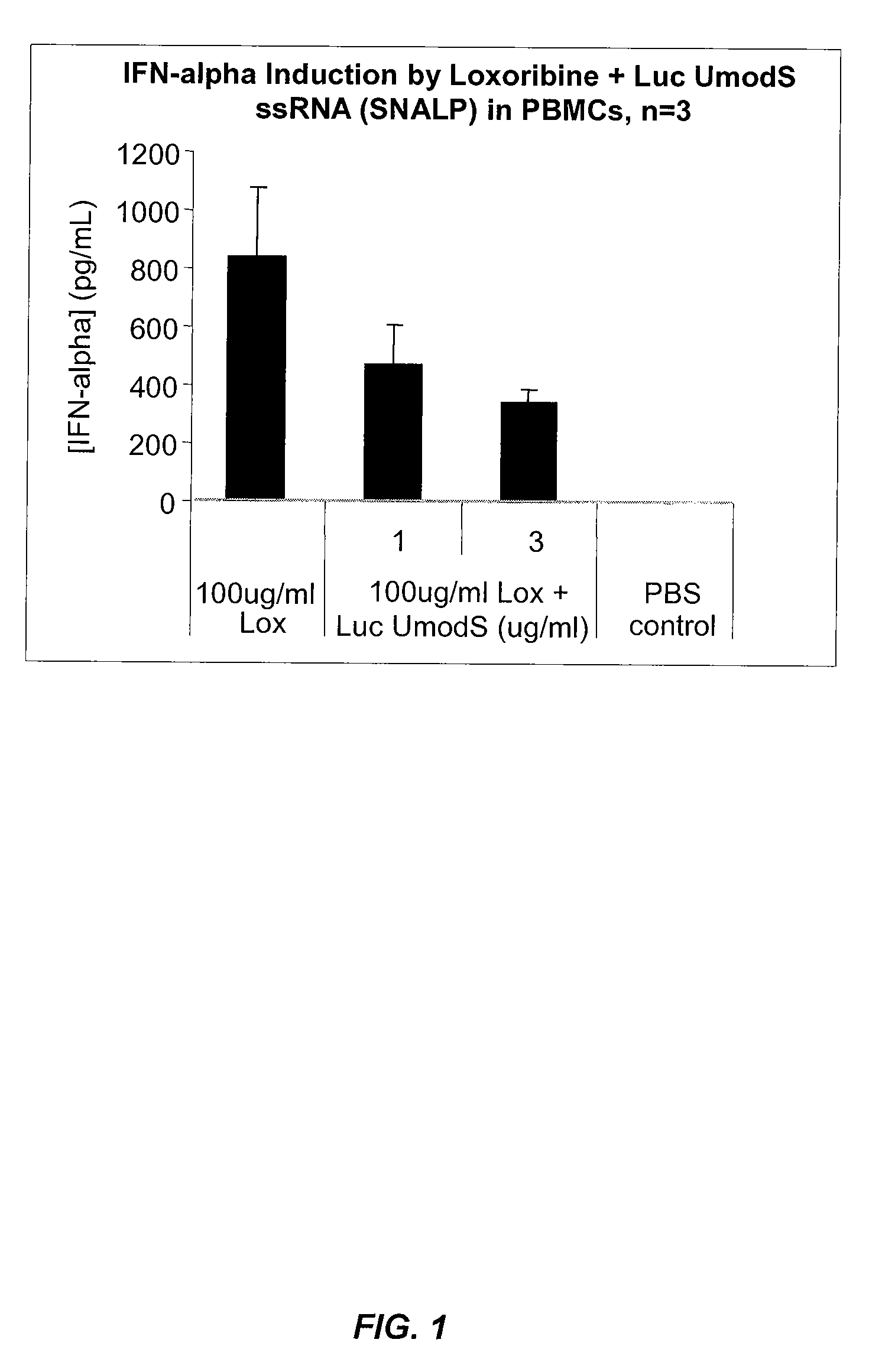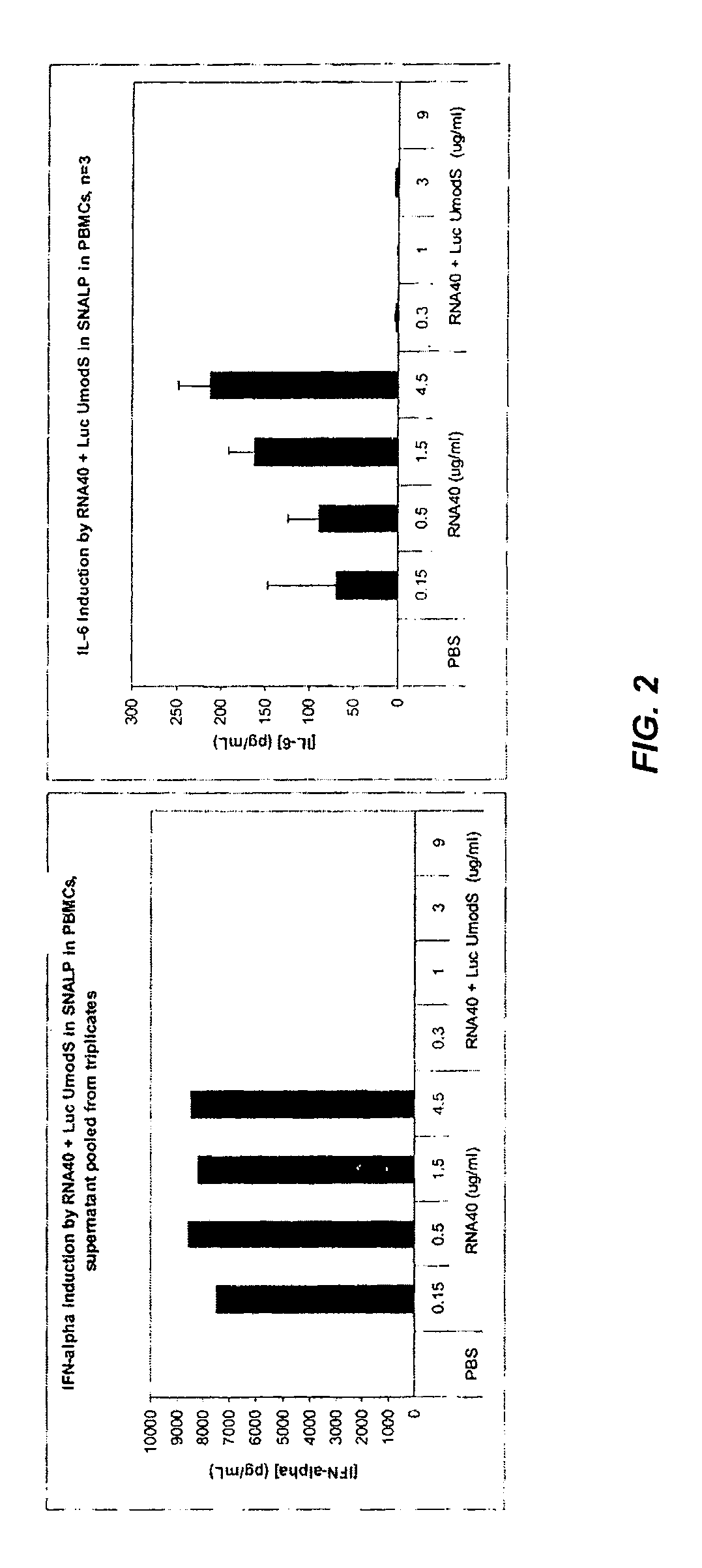Nucleic acid modulation of toll-like receptor-mediated immune stimulation
a toll-like receptor and immune stimulation technology, applied in the field of nucleic acid modulation of toll-like receptor-mediated immune stimulation, can solve the problems of triggering inflammation destructive to host tissues, affecting the survival rate of patients, so as to achieve the effect of reducing cytokine production, reducing cytokine production, and reducing cytokine production
- Summary
- Abstract
- Description
- Claims
- Application Information
AI Technical Summary
Benefits of technology
Problems solved by technology
Method used
Image
Examples
example 1
Modulation of Immune Response to Toll-Like Receptor Agonists by Modified Single-Stranded RNA
[0294]This example illustrates that the immunostimulatory activity of TLR7 / 8 agonists can be selectively antagonized by single-stranded RNA (ssRNA) having 2′OMe modifications at every uridine residue (“UmodS”).
Methods
[0295]Nucleic acid molecules having the sequences shown in Table 1 were used in this study. The Luc sense strand ssRNA corresponds to nucleotides 1302-1320 of luciferase sequence X84847. The β-gal sense strand ssRNA corresponds to the reverse complement of nucleotides 364853-364871 of E. coli K12 sequence U00096. The GFP sense strand ssRNA corresponds to nucleotides 1801-1819 of green fluorescent protein sequence AY299332.
TABLE 1Luc UmodSsense5′G A mU mU A mU G mU C C G G mUmU A mU G mU A U U 3′β-galsense5′C U A C A C A A A U C A G C G AU U U U U 3′GFPsense5′G G C U A C G U C C A G G A G CG C A U U 3′polyU215′mU mU mU mU mU mU mU mU mU mU mUmU mU mU mU mU mU mU mU mU mU 3′polyU15...
example 2
Modulation of Immune Response to Immunostimulatory RNA by Modified Single-Stranded RNA
[0302]This example illustrates that the immunostimulatory activity of ssRNA (e.g., antisense RNA) or siRNA can be antagonized by non-complementary ssRNA having 2′OMe modifications at every uridine (“UmodS”) residue when the immunostimulatory RNA and modified ssRNA are co-formulated in the same SNALP.
Methods
[0303]Nucleic acid molecules having the sequences shown in Table 2 were used in this study. The NP 1496 sense strand ssRNA corresponds to nucleotides 1498-1516 of influenza nucleocapsid protein (NP) sequence NC—004522. The Luc sense strand ssRNA corresponds to nucleotides 1302-1320 of luciferase sequence X84847. The β-gal sense strand ssRNA corresponds to the reverse complement of nucleotides 364853-364871 of E. coli K12 sequence U00096. The β-gal antisense ssRNA corresponds to 364853-364871 of E. coli K12 sequence U00096. The ApoB antisense ssRNA corresponds to the reverse complement of nucleoti...
example 3
2′-O-Methyl-Modified RNA Molecules Act as TLR7Antagonists
[0311]This example illustrates that 2′OMe-modified RNA molecules act as potent inhibitors of RNA-mediated cytokine induction in both human and murine systems. This activity does not require the direct incorporation of 2′OMe nucleotides in the immunostimulatory RNA or that the 2′OMe nucleotide-containing RNA be annealed as a complementary strand to form a duplex. Gene expression analysis of cultured Flt3L-derived dendritic cells (DC) confirmed that 2′OMe-modified RNA blocked the induction of a panel of cytokine and interferon response genes in response to unmodified RNA. These results indicate that 2′OMe-modified RNA molecules act as potent antagonists of immunostimulatory RNA. This example further shows that 2′OMe-modified RNA molecules are able to significantly reduce both IFN-α and IL-6 induction by the small molecule TLR7 agonist loxoribine in human PBMCs, murine Flt3L DCs, and in vivo in mice. These results indicate that 2...
PUM
| Property | Measurement | Unit |
|---|---|---|
| Length | aaaaa | aaaaa |
| Immunostimulation | aaaaa | aaaaa |
| Pharmaceutically acceptable | aaaaa | aaaaa |
Abstract
Description
Claims
Application Information
 Login to View More
Login to View More - R&D
- Intellectual Property
- Life Sciences
- Materials
- Tech Scout
- Unparalleled Data Quality
- Higher Quality Content
- 60% Fewer Hallucinations
Browse by: Latest US Patents, China's latest patents, Technical Efficacy Thesaurus, Application Domain, Technology Topic, Popular Technical Reports.
© 2025 PatSnap. All rights reserved.Legal|Privacy policy|Modern Slavery Act Transparency Statement|Sitemap|About US| Contact US: help@patsnap.com



